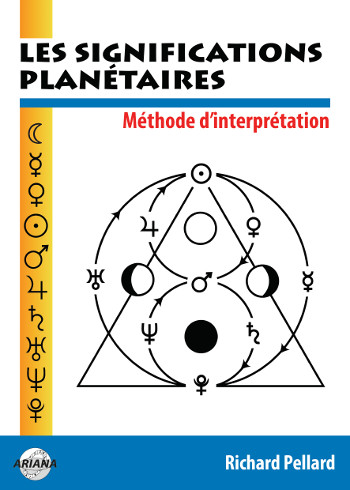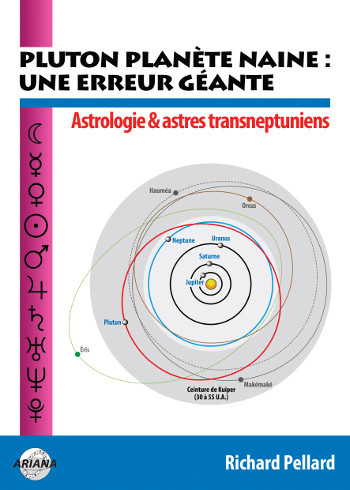Your Planets
Portraits of the Planets
Aspects between Planets
The planetary ages
The planetary families
Planets in Signs
The Planets in comics


The interpretation examples that we are suggesting are very far from being exhaustive: they only show and outline a general frame describing the issues of the planetary family. They should therefore not be taken literally. Each being brings indeed its own responses, more or less original, to the questions raised by a planetary family. There is no magic formula. Through using the R.E.T. and the Theory of Ages and combining logic, observation and imagination, you will be able to develop a thousand other possible meanings, a thousand other variations on the same theme.
These quintets have in common to be composed of a family “extensive” and a family “intensive” belonging to the same level ‘R’, ‘E’ or ‘T’ of the R.E.T., of which they highlight the positive characteristics to the maximum, while underlining the lacks and the weaknesses.
These five Planets bring together families ‘R’ (Extensive representation of Sun-Mercury-Venus) and ‘r’ (intensive representation of Sun-Jupiter-Uranus).
Psychologically: The subject knows how to both expose himself (‘R’) and impose himself (‘r’) as a model and social figure. He is both sociable, playful and charming (Sun-Mercury-Venus) and directive, ambitious and proactive (Sun-Jupiter-Uranus). The Sun is the central function: extreme need to be recognized, valued, to attract attention. If the Sun is not dominant or very dissonant, the subject may find it difficult to realize his unity, to stabilize himself in his social role. This “hyper-rR” quintet is the opposite-complementary of “non-rR” quartet composed of Mars, Saturn, Neptune and Pluto. If the five planets of this quintet dominate in a Chart, the “non-rR” quartet is necessarily non-dominant, hence the deficiencies in extensive Existence (lacks the considered realism of Mars-Saturn), intensive existence (lacks the sensory and Mars-Neptune inspired responsiveness), intensive transcendence (lack of critical thinking and perspective of Saturn-Pluto) and Extensive Transcendence (lack of prospective imagination and intuition of Neptune-Pluto).
These five Planets bring together families ‘E’ (extensive Existence of Mars-Jupiter-Saturn) and ‘e’ (intensive existence of Venus-Mars-Neptune).
Psychologically: The subject knows how to both expose himself (‘E’) and impose himself (‘e’) as a being of flesh and tangible achievements. It is both active, pragmatic and reflective (Mars-Jupiter-Saturn) and affective, reactive and inspired (Venus-Mars-Neptune). Mars is the central function: extreme need to be able to achieve concrete things, to lead a fight. If Mars is not dominant or very dissonant, the subject may find it difficult to accept the reality of the raw facts, to confront himself frankly. This “hyper-eE” quintet is the opposite-complementary of “non-eE” quartet composed of Sun, Mercury, Uranus and Pluto. If the five planets of this quintet dominate in a Chart, the “non-eE” quartet is necessarily non-dominant, hence the deficiencies in Extensive representation (lack of spontaneous and playful sociability of Sun-Mercury), intensive representation (lack of declared ambitions and clear Sun-Uranus ideals), intensive transcendence (lack of curiosity and sense of the complexity of Mercury-Pluto) and Extensive Transcendence (lack of forward-looking imagination and uncompromising voluntarism of Uranus-Pluto).
These five Planets bring together families ‘t’ (intensive transcendence of Mercury-Saturn-Pluto) and ‘T’ (Extensive Transcendence of Uranus-Neptune-Pluto).
Psychologically: The subject knows how to both expose himself (‘T’) and impose himself (‘t’) as a being of deep reflection and prospective imagination. It is both curious, insightful and profound (Mercury-Saturn-Pluto) and inspired, intuitive and unpredictable (Uranus-Neptune-Pluto). Pluto is the central function: extreme need to approach the mystery, quest for maximum lucidity. If Pluto is not dominant or very dissonant, the subject may find it difficult to accept that there may be unexplainable and inexpressible things. This “hyper-tT” quintet is the opposite-complementary of “non-tT” quartet composed of Sun, Venus, Mars and Jupiter. If the five planets of this quintet dominate in a Chart, the “non-tT” quartet is necessarily non-dominant, hence the deficiencies in Extensive representation (lack of spontaneous and charming sociability of Sun-Venus), intensive representation (lack of declared social ambitions and clear Sun-Jupiter ideals), intensive existence (lack of sensoriality and affective reactivity of Venus-Mars) and extensive Existence (lack of combative and pragmatic realism of Mars-Jupiter).

Les significations planétaires
par
620 pages. Illustrations en couleur.
La décision de ne traiter dans ce livre que des significations planétaires ne repose pas sur une sous-estimation du rôle des Signes du zodiaque et des Maisons. Le traditionnel trio Planètes-Zodiaque-Maisons est en effet l’expression d’une structure qui classe ces trois plans selon leur ordre de préséance et dans ce triptyque hiérarchisé, les Planètes occupent le premier rang.
La première partie de ce livre rassemble donc, sous une forme abondamment illustrée de schémas pédagogiques et tableaux explicatifs, une édition originale revue, augmentée et actualisée des textes consacrés aux significations planétaires telles qu’elles ont été définies par l’astrologie conditionaliste et une présentation détaillée des méthodes de hiérarchisation planétaire et d’interprétation accompagnées de nombreux exemples concrets illustrés par des Thèmes de célébrités.
La deuxième partie est consacrée, d’une part à une présentation critique des fondements traditionnels des significations planétaires, d’autre part à une présentation des rapports entre signaux et symboles, astrologie et psychologie. Enfin, la troisième partie présente brièvement les racines astrométriques des significations planétaires… et propose une voie de sortie de l’astrologie pour accéder à une plus vaste dimension noologique et spirituelle qui la prolonge et la contient.
Téléchargez-le dès maintenant dans notre boutique

Pluton planète naine : une erreur géante
par
117 pages. Illustrations en couleur.
Pluton ne fait plus partie des planètes majeures de notre système solaire : telle est la décision prise par une infime minorité d’astronomes lors de l’Assemblée Générale de l’Union Astronomique Internationale qui s’est tenue à Prague en août 2006. Elle est reléguée au rang de “planète naine”, au même titre que les nombreux astres découverts au-delà de son orbite.
Ce livre récapitule et analyse en détail le pourquoi et le comment de cette incroyable et irrationnelle décision contestée par de très nombreux astronomes de premier plan. Quelles sont les effets de cette “nanification” de Pluton sur son statut astrologique ? Faut-il remettre en question son influence et ses significations astro-psychologiques qui semblaient avérées depuis sa découverte en 1930 ? Les “plutoniens” ont-ils cessé d’exister depuis cette décision charlatanesque ? Ce livre pose également le problème des astres transplutoniens nouvellement découverts. Quel statut astrologique et quelles influences et significations précises leur accorder ?
Enfin, cet ouvrage propose une vision unitaire du système solaire qui démontre, chiffes et arguments rationnels à l’appui, que Pluton en est toujours un élément essentiel, ce qui est loin d’être le cas pour les autres astres au-delà de son orbite. Après avoir lu ce livre, vous saurez quoi répondre à ceux qui pensent avoir trouvé, avec l’exclusion de Pluton du cortège planétaire traditionnel, un nouvel argument contre l’astrologie !
Téléchargez-le dès maintenant dans notre boutique